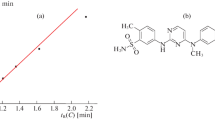Summary
The physico-chemical framework is examined by comparing the predictions of three models for the combined effects of the composition of the hydroorganic mobile phase and the column temperature on the retention ofn-alkylbenzenes on hydrocarbonaceous bonded stationary phases. The “well-mixed” model leads to expressions for the dependence of retention on three factors which are equivalent to those derived previously from linear extrathermodynamic relationships. The “diachoric” model stems from the assumption that the mobile phase is microscopically heterogeneous and the “displacement” model is identical to the retention model most widely used in chromatography with polar sorbents and less polar solvents. Over limited ranges of mobile phase composition and temperature, each model does describe retention behavior. However, only the wellmixed model describes retention well over the entire range of mobile phase composition and temperature studied here. The success of the well-mixed model, and its limits, give insight into the role of the organic solvent in determining the magnitude of chromatographic retention on non-polar stationary phases with hydro-organic eluents.
Similar content being viewed by others

References
W. R. Melander, B.-K. Chen, Cs. Horváth, J. Chromatogr.,185, 99–109 (1979).
W. R. Melander, A. Nahum, Cs. Horváth, J. Chromatogr.,185, 129–152 (1979).
W. R. Melander, Cs. Horváth, J. Jacobson, J. Chromatogr.,234, 269–276 (1982).
A. Nahum, Cs. Horváth, J. Chromatogr.,203, 53–63 (1981).
K. E. Bij, Cs. Horváth, W. R. Melander, A. Nahum, J. Chromatogr.,203, 65–84 (1981).
Cs. Horváth, W. Melander, I. Molnár, J. Chromatogr.,125, 129 (1976).
B. L. Karger, J. R. Gant, A. Hartkopf, P. Weiner, J. Chromatogr.,128, 65 (1976).
L. R. Snyder, J. W. Dolan, J. R. Gant, J. Chromatogr.,165, 3 (1979).
W. R. Melander, Cs. Horváth, in: High Performance Liquid Chromatography, Vol. 2,Cs. Horváth, ed., Academic Press, New York, 1980, pp. 114–319.
W. Melander, D. E. Campbell, Cs. Horváth, J. Chromatogr.,158, 215–225 (1978).
H. Colin, J. C. Diez-Masa, G. Guiochon, T. Czajkowska, I. Miedziak, J. Chromatogr.,167, 41 (1978).
L. R. Snyder, J. Chromatogr.,179, 167 (1979).
C. M. Riley, E. Tomlinson, T. M. Jefferies, J. Chromatogr.,185, 197 (1979).
P. J. Schoenmakers, H. A. H. Billiet, L. de Galan, J. Chromatogr.,185, 179 (1979).
D. C. Locke, J. Chromatogr. Sci.,12, 433 (1974).
D. C. Locke, in: Advances in Chromatography, Vol. 14,J. C. Giddings, E. Grushka, J. Cazes andP. R. Brown, eds., Marcel Dekker, 1976, pp. 87–198.
N. L. Ha, J. Ungvarai, E. sz. Kováts, Anal. Chem.,54, 2410 (1982).
W. R. Melander, J.-X. Huang, Cs. Horváth, in preparation.
J. F. K. Huber, E. Kendler, H. Markens, J. Chromatogr.,167, 291 (1978).
J. H. Hildebrand, J. M. Prausnitz, R. L. Scott, Regular and Related Solution, Van Nostrand Reinhold, New York, 1970.
J. H. Purnell, J. M. Vargas de Andrnde, J. Amer. Chem. Soc.,97, 3585 (1975).
R. J. Laub, J. H. Purnell, J. Amer. Chem. Soc.,98, 30 (1975).
L. R. Snyder, Principles of Adsorption Chromatography, Marcel Dekker, New York, 1968.
L. R. Snyder, in: Chromatography, 3rd ed.,E. Heftmann, ed., van Nostrand Reinhold, New York, 1975, pp. 46–76.
M. McCann, H. Purnell, C. A. Wellington, Faraday Society Symposium,15, 83 (1980).
I. Langmuir, J. Amer. Chem. Soc.,38, 2221 (1916).
W. R. Melander, C. A. Mannan, Cs. Horváth, Chromatographia,15, 611 (1982).
R. M. McCormick, B. L. Karger, J. Chromatogr.,199, 259 (1980).
E. H. Slaats, W. Markovski, J. Fekete, H. Poppe, J. Chromatogr.,207, 299 (1980).
O. Sinanoǵlu, in: Molecular Associations in Biology,B. Pullman, ed., Academic Press, New York, 1968, pp. 427–445.
O. Sinanoǵlu, in: Molecular Interactions, Vol. 3,H. Ratajczak andW. J. Orville-Thomas, eds., Wiley, New York, 1982, pp. 281–342.
Author information
Authors and Affiliations
Additional information
Dedicated to Professor S. R. Lipsky on the occasion of his 60th birthday.
Rights and permissions
About this article
Cite this article
Melander, W.R., Horváth, C. Mobile phase effects in reversed-phase chromatography VI. Thermodynamic models for retention and its dependence on mobile phase composition and temperature. Chromatographia 18, 353–361 (1984). https://doi.org/10.1007/BF02262480
Received:
Accepted:
Issue Date:
DOI: https://doi.org/10.1007/BF02262480



